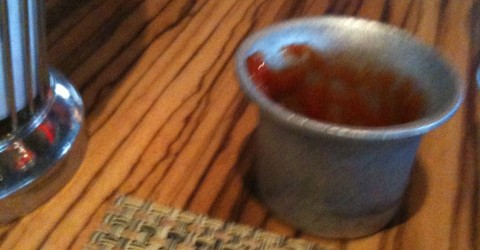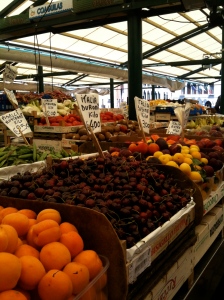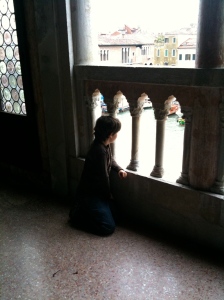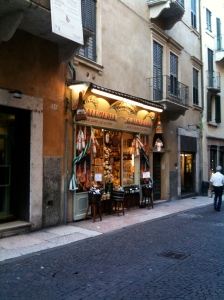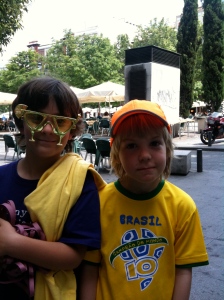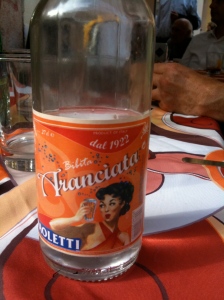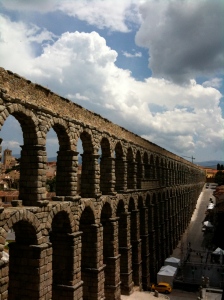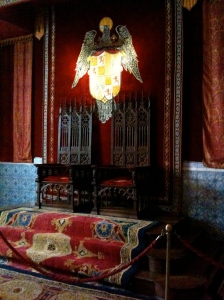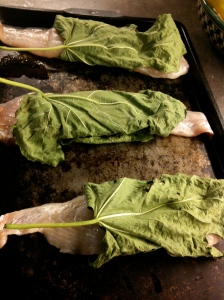recipes 24 & 25; quesadillas (again) and Halibut Baked on a Fig Leaf
That the measure of a great trip is how happy you are to return home was never more clear to me than two weeks ago when Jim, Luca and I returned from Italy and Spain. After a grueling trip home, that because we were using our frequent flier miles, involved a twelve hour flight from Madrid to Mexico City on a flight packed with Mexican football fans returning from Mexico’s elimination in the World Cup, and an overnight in a shabby airport hotel, we landed at LAX at 9:30 in the morning. Weirdly energized by jetlag and the luck of it being Wednesday I was at the Farmer’s Market by 11AM loading up on summer’s bounty: apricots, peaches, green beans and zucchini. When I got home, Luca was at the stove making his beloved quesadilla. I made a salad of fresh greens and we all dug in. After two weeks of a diet that consisted mostly of cheese, wine, pasta and just about every possible kind of pig meat, we were too excited about eating our own food to think about the sleep we so desperately needed.
Normal people plan their trips around museums and famous basilicas. We scour Chowhound.com and other foodie sites for places to eat like locals. In much of Italy this advance research isn’t necessary as you can eat well just about anywhere, including as Jim and I found out once, in the Autostrada rest stops where we had great coffee and sandwiches. But we knew from previous experience that you can eat very badly in Venice and spend a lot of money while you’re at it. So armed with a trusty list of off-the-beaten-track restaurants, and no plans to enter a basilica of any kind, the three of us set out to walk the world’s most beautiful city.
Because Luca is Luca, he had no trouble planning the day around the best pizza in Venice (Il Refolo) or a nice plate of fritti misti (Il Vecchio Fritolin).
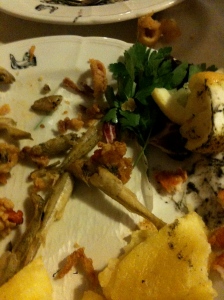
This seafood fritti misti with polenta was so delicious I forgot to snap a photo until it was all gone.
When Luca was a toddler we traveled all over Europe and found that, though he happily sat still for a three hour lunch, he howled in agony upon crossing the threshold of a museum, no matter what kind. We planned museum visits around his naptime and then had to keep him moving in the stroller, doing absurd figure eights through the galleries lest he should wake up and find himself in front of the Mona Lisa and start screaming.
This time around he’d have to suck it up. As an eight year old, he’d have to walk on his own two feet and keep his irritation to himself. The truth is that I don’t have much more tolerance for museums than he does, and this is especially true of big important museums stuffed with religious paintings. I think we learn as much from food as from art, and whatever it says about me, treating museums as stopovers on the way to great food works for me as much as for my eight-year old kid. We got off to a good start in Milan at the Leonardo Da Vinci Museum of Science and Technology where they have constructed wooden models of Leonardo’s technological drawings; bridges, flying machines, weaving looms. But at the Galleria Accademia in Venice Luca’s shoulders slumped almost immediately and he began to moan that he was bored and hungry after only a few minutes. I couldn’t blame him. Nor could I explain the significance in wall after wall of the Madonna and Child or the gruesome depictions of saints being tortured. Luca stopped in front of a particularly grisly portrait of a saint having the thigh muscle cut off by several knife-wielding unbelievers intent on their business. Momentarily absorbed, he wanted answers. “I don’t get it. Why is there so much torture?”
“I don’t know,” I answered lamely and pulled out the list of restaurants and a map. The painting may have been a Tintoretto but it was oppressive enough that three minutes later we were bounding across bridges on our way to the Venice fish market.
Having no place to cook, we bought no fish but, while Luca watched the garbage boat loading, we bought some lovely apricots at the next-door fruit market. For some reason the sight of the garbage boat with its little crane lifting and placing garbage made Luca laugh, so we stood there a while eating apricots while Luca giggled at the garbage boat.
Luca did better at the Peggy Guggenheim Collection, where, with a steady, lashing rain beginning to pour, we had fun looking at the photos of Peggy in these very rooms with these very works of art surrounding her. It was a relief after the heaviness of the Galleria Accademia, imagining what it must have been like to live here on the Grand Canal with your very own gondola at the front door and with playful works by Picasso and Brancusi hanging in your dining room and, in the bedroom, a silver headboard made by Calder (I have read that this last caused some uncomfortable moments during Peggy’s many romantic encounters). Luca was especially enchanted by the blue glass sculptures made from Picasso’s drawings that sit in a window through which you can watch the traffic of the vaporettos and delivery boats on the Grand Canal.
We squeezed in visits to the Ca’ D’Oro and the Palazzo Ducale between meals at San Trovaso where we ate squid ink pasta with big tender hunks of squid, and Alla Vedova where we ate our freshest meal of chicchetti; white beans and onions, sarde en saor, vegetable antipasti, and their famed meatballs.
Aside from some 12th Century bronzes, the Ca D’Oro was a trial for Luca that no amount of enthusiasm on my part could alleviate. He managed to amuse himself by sitting on the loggia overlooking the considerable action on the Grand Canal, mostly unchanged since the 13th century when other little boys, bored by the goings on in the palace itself, might have been enchanted by the same view.
The Palazzo Ducale was a lot more fun, part museum and part living-history playground for Luca. With a belly full of a rich béchamel and porcini lasagne he spent the better part of a rainy afternoon in the armory picking out his weapons of choice (crossbow and sling), and in the dank prison cells where he alternately pretended to be a guard and a prisoner.
Blaming it on the long line snaking through the Piazza San Marco in the rain, we skipped the Basilica.
With the World Cup heating up, we watched Cameroon play Denmark in the Campo Santa Margherita where a small crowd huddled under awnings to stay out of the rain while sipping on beer or the incredibly refreshing Venetian spritz made with Prosecco, campari and soda water. The next night, with the rain still pouring, we had the luck to run into a little snack bar draped in Brazilian flags and offering caipirinhas. The place was cozy and dry so we stayed to watch Brazil beat Ivory Coast and made a dinner of tiny sandwiches and their version of the spritz made with Aperol and vodka.
It is said that no visit to Venice is complete without getting utterly and hopelessly lost and that night our visit was made complete as we traipsed through a bleak and eerie part of the Dorsoduro in the rain. Glimpses of the lights of cruise ships only disoriented us further until we found ourselves, blocks from our hotel, in a deserted courtyard of a police station with an armada of smart little police boats bobbing at the docks.
In Verona, we avoided the local specialty of horsemeat stew and had a picnic of cheese, salami, bread, wine and artichokes on the banks of the Adige River. In the distance was the 12th century Castelvecchio where Luca had passed the morning shooting imaginary crossbows off turrets at the enemy advancing from the river.
Then it was off to the much hotter and drier Madrid. We checked into our hotel and immediately went out to find Luca’s beloved and much-anticipated giant pile of chorizo.
At the Reina Sofia Museum Luca learned about the horrors or the Spanish Civil War through works by Picasso with titles such as “Mother With Dead Child,” and his giant “Guernika.” Interspersed throughout the galleries were flat screen TV’s on which were shown odd little early experimental films and, to the delight of the loudly guffawing Luca, a 22 minute Buster Keaton short called “The Week.” While I tried to interest Luca in wondrous portraits by Miro he became engrossed in a documentary film about the war. Arguing about why he should be allowed to watch it for the third straight time, he said emphatically: “Mommy, this is history. It’s real. This,” he said with a sweeping gesture encompassing all the great works hanging on the walls, “is not.” I tried explaining that history is understood through art as much as through the so-called “facts,” but Luca’s eyes were glued to the screen where grainy images of dead children flickered. When did he become so literal?
That night we ate at El Mollete, a tapas restaurant in an old charcoal cellar so tiny that there are little luggage racks above the tables. We had an avocado salad that came wrapped in smoked salmon, a plate of tender, spicy pulpo, pork stuffed with cherries and blackberries, and best of all, fiilo dough saquetes of goat cheese drizzled with honey.
The next day we were joined by our good friends from London; Nina (one half of the brilliant tropical/rock/pop band Zeep), and her son Johan who was a great pal of Luca’s when we lived in London. Fellow Brasil supporters, Nina and Johan arrived with a suitcase full of carnival paraphernalia and just in time to watch the match between Brasil and Portugal in the Plaza Santa Ana. In contrast to the more staid piazzas in Venice and Verona, the Plaza Santa Ana was hot, loud and smoky and, though less beautiful, a lot more fun.
Sitting on the Plaza we noticed a small but steady stream of people in yellow and green heading to a little bar on the corner and a couple of minutes later we were speaking Portuguese and enjoying a nice plate of paella accompanied by a delightfully chilled light red wine. Brasil won the match 3-1 and just then it would have been hard to improve upon our mood.
The boys braved a walk in the 90 degree heat to the Parque Retiro where they had ride on the lake in a rowboat. Afterwards they played soccer in the rain and it was off for another tapas meal; jamon iberico and cheese. Walking with the boys in the heat, it turned out, required regular stops for ice cream and “Fanta Naranja” which in Italy Luca discovered by the name of “Aranciata.”
The last museum of the trip turned out to be the most trying for me and, surprisingly, the least so for Luca. On the way to the Prado, Luca and Jim peeled off to fix a shoe problem of Luca’s and I went into the museum with Nina and Johan. Johan, who is incredibly easy-going and quiet, began to squirm the minute we joined the line for tickets. As I watched Johan in silent tears, literally wringing his little body away from the gloomy paintings on the wall, I wondered how Luca was faring, if he was being tortured as Johan now was, very like the victims portrayed in Goya’s dark works.
We lasted about an hour before we desperately fumbled for an exit, an hour that was a testament to Johan’s forbearance. Luca who is much more vocal would have complained so loudly that it would have been impossible to stay more than a few minutes.
Nina, Johan and I ended up waiting for over an hour outside the Prado for Jim and Luca to emerge, an hour I spent worrying for Luca’s mental health in the face of the monstrous faces of Goya’s masses and the firing squads. When I finally saw Luca bounding towards me across the expanse of the museum’s entrance, he was smiling and saying: “that was my favorite museum, Mommy!”
Then we were off to El Mollete again, this time with friends in tow. When the waiters saw us for the second time in two days, they sat down and shook our hands like we were old friends. We ate well, too well, and then took a long walk through the neighborhoods of La Latina and Lavpies which were deserted in the afternoon heat.
That night Jim watched the boys – and a match between USA and Ghana – while Nina and I went out to see Flamenco at Casa Patas (which turns out to be the best place in Madrid for Flamenco). I had never seen Flamenco and didn’t know what to expect. It didn’t take more than a couple of minutes for me to be completely enraptured with the clapping and percussive foot stamps of the melancholy, mournful singers. The guitar playing was extraordinary, brilliant really, and the dancing was jaw dropping. Everything was sexy and dynamic and musically rich and Nina and I wanted more of all of the performers, the whole gorgeous sextet of them.
High on great music and dancing, we went back to the Brazilian place on Santa Ana and drank a bottle of wine and ate an enormous plate of ham while we watched the thick parade of people walking by the windows. At one point we noticed that the people in the streets, though it was nearing 1AM, were not drunk in the least. They were merely enjoying the night, eating and drinking and, because this was Spain they were of course, smoking. We also observed the way in which the hipness of modern Spain has embraced traditional Spanish culture rather than casting it aside. The big hams hanging in the bars, the wine, the midday siesta which is no longer a siesta of course but which the Spaniards cling to nevertheless, even Flamenco; all of these are part of the new modern here.
The day after Nina and Johan returned to London, Luca, Jim and I took the train to Segovia. There we had a drink and an ice cream under the perfectly intact Roman Aqueduct and then walked across town to the Alcazar, a 12th century castle built in the shape of a ship’s prow on the confluence of two rivers.
This castle was mostly left as as is, and not unlike in the Peggy Guggenheim Collection, it was easy to imagine life as it must have been when people actually lived here. The Fireplace room had its original dining table and chairs, the bedroom had what seemed like a strangely modest bed, and there was even a real throne in the Throne room. Luca examined the weapons in the armory before climbing the 152 circular steps of the Torre San Juan II, and at the top he fought another valiant battle against encroaching enemy forces using (I think) a canon and crossbows.
By this point in our journey my stomach was on strike so we bypassed the whole suckling pig that Segovia is famous for and had a little snack of cheese and bread before heading to the train station. This was our last day in Spain and we spent it by turns arguing with officious train station clerks and watching the rain fall on the Spanish plain from the top of a medieval castle.
Two days later we are home and, by noon, all settled down at the table to eat Luca’s quesadillas and greens from the Farmer’s Market. “Mmmmm,” I said. “Fresh California salad.”
“I want some Fresh California salad!” Luca said as though this were its name. I heaped a mound of it on his plate and the colors were various hues of almost fluorescent green. He ate a big bite and then dug back into his beloved quesadilla. Less than an hour after landing at LAX, he had been at the stove reuniting with the familiar flavors of home.
________________________________________________________
By the way, for Mother’s Day Luca finally made the much-anticipated Halibut Baked on a Fig Leaf. I have had fish wrapped in all kinds of things and usually I can’t see what the fuss is about. But this was different, another example of Alice Waters’ genius for making the simplest foods indescribably delicious. The fig leaves (harvested from our friend’s tree) gave the fish a slightly nutty taste and the halibut itself was so tender it melted in my mouth. Luca had wanted to make all three meals that day for me including breakfast in bed, but I convinced him that one meal was enough. And it was!
